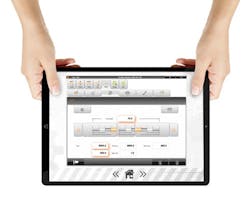Most machine builders no longer have to be sold on the benefits of remote access to PC-based and embedded HMI servers by remote thin clients such as tablets and smartphones, but for those who still need convincing, here are some reasons to go mobile.
“For machine builder OEMs, the key to success is simplified commissioning and support of the equipment after it is in production,” says Chirayu Shah, commercial program leader for HMI software at Rockwell Automation. “With remote-access capability, OEMs can check diagnostic messages or machine status, and they can receive notifications or alerts based on specific conditions during the operations. This flexibility means OEMs don’t have to be physically on-site to troubleshoot issues.”
Other good reasons for remote access are explained by Gimmi Filice, manager of HMI/SCADA at GE Digital. “OEMs benefit from remote access because they can monitor their machines at their customer sites to see how they are operating. This also benefits OEM customers by providing access to the experts who designed the machine, which can help them to optimize their assets. This can be turned into a competitive advantage as OEMs are able to provide more value to their customers.”
The HTML5 standard is simplifying remote access, and this standard has been widely adopted throughout both the industrial and commercial sectors. As recently as a couple of years ago, remote access to PC-based and embedded HMI servers via thin client browsers was limited to platforms running Windows-based operating systems, and in some cases Apple smartphones and tablets. But now, any piece of hardware supporting the HTML5 standard can be used for browser-based access. Since almost every operating system supports the standard, remote access is no longer device-dependent.
Back in the day, it was very hard for suppliers to provide browser-based access, as each operating system had its own requirements. “Software in the past was very operating-system-specific and limited which devices could be used to display HMI screens,” explains Filice. “Suppliers not only had to design remote access into their HMI software for each operating system/remote device, they also had to continually update their software to keep up with remote device operating system updates, patches and revisions.”
Figure 1: The HTML5 standard allows a variety of remote devices including tablets and smartphones, to clearly display information from PC-based HMI software.
Source: B&R Automation
With the HTML5 standard, this customization is no longer required, as all that’s needed to make a device an HMI thin client is compliance with the HTML5 standard by the HMI software and the remote device OS. “HTML5 is widely available on a variety of devices including Windows, iOS, Android and Linux—providing platform independence. This allows us to focus on delivering solutions to provide timely information to the operator regardless of their location, without worrying about the underlying technology,” adds Filice.
Virtually every major HMI software vendor is onboard with HTML5, including Rockwell Automation. “HTML5 is a recognized, worldwide standard,” says Shah. “The majority of technology vendors like Apple, Microsoft and Google support HTML5 technology in their Web browsers for all devices, from standard PCs and laptops to tablets and smartphones. We built our Web-based solution using this standard to allow customers flexibility regarding which form factor to use. With one rendering engine in our product, we are able to bring plant-floor information to all of the most popular devices.”
Because suppliers don’t need to continually update their HMI software to comply with remote-device operating-system changes, machine builders gain more stable remote access. “The benefits to our machine-builder customers are future-proofing HMI development by utilizing a Web standard and not relying on any proprietary code base,” points out Derrick Stacey, a solutions engineer at B&R Industrial Automation.
“HTML5 also provides a more familiar look and feel for machine user interfaces, similar to consumer devices, leading to a decrease in training required to operate a machine and decreasing or eliminating errors caused by operator fatigue,” notes Stacey (Figure 1).
Shah also mentions longevity benefits. “Adopting this standard ensures investments our customers make into our products and solutions are future-proof,” says Shah. “Longevity and sustainability of plant solutions are critical to customers. We have also developed best-practice architectures with our partner Cisco to ensure communication layers are secured to avoid any security risks from the customer perspective. We provide write-back capability to our HMI from these mobile devices, and that provides an even higher level of flexibility to the customer base.”
Security concerns addressed
HTML5 has many built-in security tools, and, since they’re effectively standardized, your company’s IT department can use these familiar tools to help make remote access to your HMI software secure. “Security is managed by the application or as necessary by the IT group, so authorization of users is centralized,” explains Richard Clark, applications engineer at InduSoft-Wonderware/Schneider-Electric Software.
“Device authentication is not a concern since authorization is remotely managed, and any generic device with an appropriate Web browser and HTML5 support will be capable of becoming a thin client for the runtime application on the server device,” continues Clark.
“The HTML5 client is not capable of sending direct commands to run code on the server application or machine or accessing any data that is not presented in the application display. All access to automation and process data is thus behind the gatekeeper of the runtime application on the HTML5 server,” concludes Clark.
What about screen size?
Another improvement to remote access fostered by the HTML5 standard is automatic sizing of screens based on the particular device. “In addition to ease of use, one of the biggest benefits of our TwinCAT HMI software is that the HTML5 is rendered natively, rather than converted as with other similar systems,” explains Daymon Thompson, an automation specialist at Beckhoff Automation.
“The result is a simple means to display an HMI for machines and entire plants on any piece of glass. Any operating system with a modern browser can display the TwinCAT HMI, and the system automatically sizes and scales the display to fit the device,” adds Thompson.
Automatic sizing is a built-in feature of HTML5, so all suppliers adopting the standard can pass this benefit on to their customers. “HTML5’s scalable vector graphics allow HMI screens to be represented clearly on many device screen sizes and resolutions,” says B&R’s Stacey.
The benefits of automatic screen sizing are readily apparent, and the implementation of this feature within HTML5 is a big improvement over past deployments, which required custom coding. And, as long as we’re eliminating custom coding in this area, how about getting rid of all proprietary mobile HMIs while we’re at it?
No more proprietary mobile HMIs
As HTML5 makes it ever easier to distribute PC-based and embedded HMI server information to remote client devices, including two-way access if needed, does it spell the complete demise of proprietary remote-access client devices? Machine builders hope so because proprietary devices are expensive to buy and maintain and come with a steep learning curve. On the other hand, remote access via familiar smartphones and tablets is cheap to buy, easy to maintain and simple to operate.
“HTML5 allows our HMI software to be used on a large variety of mobile devices, taking advantage of platforms that many people likely already have,” says InduSoft’s Clark. “The advantage is that the IoT and especially the IIoT can be leveraged by nearly everyone without needing to be tied to a specific platform. IoT and IIoT applications no longer need a separate graphics display device since many people already carry a compatible smart device with them, keeping the cost for creating remote access for IoT implementations very low.”
Clark takes things a step further, envisioning a future where each machine won’t require its own HMI, as groups of machines will be accessible by handheld devices. “Remote access via HTML5 is extremely beneficial to the machine builder because an onboard HMI is no longer needed,” he says. “This reduces the size and resource requirements to display an HMI screen, along with reducing the cost of the machine as well.”
BYOD and HTML5
You can’t bring your own device (BYOD) if the HMI doesn’t support your device, which was often the case before HTML5. BYOD is a method many machine builders are using to let their employees remotely access equipment installed at customer sites.
Employees like BYOD because they don’t have to carry another device and because they can use their own smartphone or tablet, with which they are very familiar. Their employers like it because they don’t have to buy and support extra remote-access devices beyond those that their employees already own and use.
Remote access has been around for decades, but thanks to HTML5 it’s now easier than ever to implement and support. As machine automation becomes more mobile, along with all forms of computing, expect HTML5 use to continue its growth.





